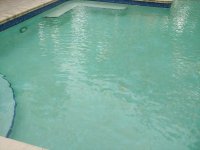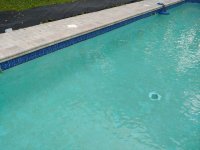Hi all, first of all huge thanks to this forum. I was introduced into the pool world through a house purchase this year, and went from "not great" initial shape, to the green algae ridden wasteland, and then SLAM'd my way to clear water and a sense of pride knowing I've (mostly) got a handle on my pool maintenance - to my friend's chagrin, as he _insisted_ that all pools needed a dedicated pool guy while his own pool sits closed for years.
I am in central Florida. This pool was installed in roughly 1993-95, and based on the upkeep of the rest of the property I am assuming it has never been resurfaced.
I am on well water, and naturally have pretty high calcium & mineral content in my fill water - so I try to use it sparingly and use it with some gardening-esque calcium filter attachments when necessary.
I don't recall if these stains were this bad before the SLAM, the water was pretty cloudy beforehand so it's possible I never noticed. I definitely noticed the stains after the SLAM, but the clear water was a much bigger win in my book. The pool has gotten a lot of use since then, so I'll take an ugly pool in exchange for safe water.
I've done a couple small vitamin C tests just scraping a pill against the plaster in a couple places. It does seem to remove the stain, although it leaves the wall almost brighter than I would have expected based on the rest of the pool. Based on that, I am assuming these are all copper stains.
I've read that plaster pool surfaces last for 5-10 years on average, and I'm assuming this one is well over that max. The walls are a bit rough (particularly the floor), and rubbing against it while underwater will leave a scrape that could break skin if you were forceful enough. The blue tile above the pool also has some large cracks around some of the corners and what looks like moss or some organic material growing between the tile and the pavers above. I don't know how to say for sure that "Yes, it's time to resurface" or "This is treatable with AA".
I also have a suspicion that I have a small leak, although I haven't confirmed. Going into fall/winter I am losing water at a rate of roughly .5-1 inch a week, which is requiring me to use more fill water since the rain isn't as frequent. I generally try to keep it at the bottom of the blue tile.
Most recent pool readings (all within the last week with a TF-100):
FC: 5 (I usually add liquid chlorine to target ~7 based on pool math app, then let it fall down to around 4.5-5 before adding again)
CYA: 50
PH: 7.5
TA: 50 (as of today, getting some baking soda this afternoon)
CH: 500
I find that I add muriatic acid almost more often than chlorine these days. The PH will rise quickly to around 8, and requires acid treatment at least once a week.
Thanks for any and all help! These spots are much more visible when the sun isn't shining on the water. When the sun is out, these spots are almost invisible unless you're under water.


I am in central Florida. This pool was installed in roughly 1993-95, and based on the upkeep of the rest of the property I am assuming it has never been resurfaced.
I am on well water, and naturally have pretty high calcium & mineral content in my fill water - so I try to use it sparingly and use it with some gardening-esque calcium filter attachments when necessary.
I don't recall if these stains were this bad before the SLAM, the water was pretty cloudy beforehand so it's possible I never noticed. I definitely noticed the stains after the SLAM, but the clear water was a much bigger win in my book. The pool has gotten a lot of use since then, so I'll take an ugly pool in exchange for safe water.
I've done a couple small vitamin C tests just scraping a pill against the plaster in a couple places. It does seem to remove the stain, although it leaves the wall almost brighter than I would have expected based on the rest of the pool. Based on that, I am assuming these are all copper stains.
I've read that plaster pool surfaces last for 5-10 years on average, and I'm assuming this one is well over that max. The walls are a bit rough (particularly the floor), and rubbing against it while underwater will leave a scrape that could break skin if you were forceful enough. The blue tile above the pool also has some large cracks around some of the corners and what looks like moss or some organic material growing between the tile and the pavers above. I don't know how to say for sure that "Yes, it's time to resurface" or "This is treatable with AA".
I also have a suspicion that I have a small leak, although I haven't confirmed. Going into fall/winter I am losing water at a rate of roughly .5-1 inch a week, which is requiring me to use more fill water since the rain isn't as frequent. I generally try to keep it at the bottom of the blue tile.
Most recent pool readings (all within the last week with a TF-100):
FC: 5 (I usually add liquid chlorine to target ~7 based on pool math app, then let it fall down to around 4.5-5 before adding again)
CYA: 50
PH: 7.5
TA: 50 (as of today, getting some baking soda this afternoon)
CH: 500
I find that I add muriatic acid almost more often than chlorine these days. The PH will rise quickly to around 8, and requires acid treatment at least once a week.
Thanks for any and all help! These spots are much more visible when the sun isn't shining on the water. When the sun is out, these spots are almost invisible unless you're under water.


Last edited:

